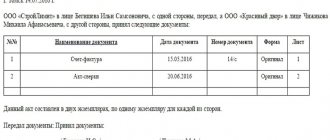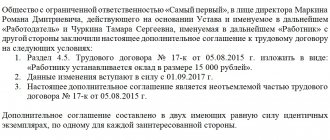Form of the act
The legislation does not provide for the mandatory use of any unified form. As a rule, each company independently develops a form for this act. However, the law requires you to include certain information here:
- Title of the document;
- Date of completion;
- the name of the company that filled out the act;
- information about the property being maintained;
- a unit of measurement in which the value of property is measured;
- detailed information about the persons between whom the transaction was concluded;
- signatures with transcripts, and other information allowing the identification of responsible employees. The document must be signed by all persons related to this transaction.
As a rule, to draw up this act, many companies use form MX-1. It is familiar and quite understandable. If the need arises, you can make the necessary adjustments to this unified form by adding or deleting certain data. Regardless of whether the company uses the MX-1 form or develops its own form, it must be certified by the company’s accounting policies.
Accounting form
To facilitate and correctly maintain records, a special form of the acceptance certificate of goods and materials has been developed. The type of this unified document was approved by Decree of the Russian State Statistics Committee No. 66 of 08/09/1999. It is included in a special album as a separate form of MX-1.
It can be divided into the following components:
1. Background information.
2. Product data.
3. Signatures of the parties.
In the first part, information about the custodian and bailor of the goods, as well as the number and date of the agreement in accordance with which this transfer is made, is sequentially entered in certain columns. This is followed by the name of the document and its details (date and serial number). The second part is a table in which all products are divided depending on the assortment. Moreover, each item is described in detail, starting with the name and characteristics, and ending with the quantity, as well as the set price. The period, place and conditions of storage of products are also indicated here. The last part includes the signatures of persons who, according to the agreement, assume very specific obligations. They should be supplemented with job titles, detailed transcripts and, if possible, certified with seals.
Why is the act needed?
In essence, this document confirms the fact of the transfer of values from one organization to another. After its conclusion and proper execution, the recipient will be fully responsible for the safety of the property. If you have to face an unpleasant situation when property is completely or partially lost or damaged, on the basis of this act it will be possible to file a claim in court. As a rule, the court obliges the guilty party to compensate for the damage caused.
If property is transferred for temporary storage, this is indicated in the document. The party transferring material assets is called the bailor. The custodian is the person who takes over the property. Moreover, the document contains information not only about the parties to the transaction and the property, but also about the conditions for proper storage. If property is transferred for storage within a certain period, upon its expiration a new act is drawn up confirming the fact of the return of material assets.
( Video : “The act of acceptance and transfer as the final point of the transaction”)
If the execution of the act occurs during an external transaction, this document can serve as an annex to the business contract. Quite often, property is transferred between different structures within the same company. In this case, the transfer must be recorded in the accounting department. Thanks to this, those responsible for accounting for material assets maintain control over the movement of property. However, there are situations when the unit is located at a fairly large distance from the company administration. If it is not possible to come for documents, the responsible persons on the spot formalize the movement of property based on the prepared forms.
When is the acceptance certificate drawn up?
The document must be executed on the very day the property is transferred. As a rule, the execution of the act is carried out by the responsible persons of the party that accepts the values. In the act they put down the date of the day on which the transaction is actually completed. Among the most common situations when it is necessary to draw up this document, it is worth highlighting:
- transfer of property for rent. As a rule, this can be real estate and equipment;
- transfer between departments of one company;
- transfer between employees when the persons responsible for the property change.
As a rule, the head of the company monitors the correctness of this document. Thanks to this, a specific person is fully responsible for the safety and proper storage of property. In addition, the document allows you to demand compensation for damage if material assets are lost or damaged.
Basic Concepts
The transfer of material assets can occur in two ways:
1. Within the enterprise when moving between areas or changing responsible persons.
2. When transferring goods outside the company.
In each of these cases, a transfer and acceptance certificate of goods and materials must be drawn up in accordance with all the rules. It is part of the primary documentation and represents one of the methods of accounting for goods.
In each particular case, such an act of acceptance and transfer of goods and materials performs a specific function. For example, when a person in charge at an enterprise changes, he records the number of goods and other materials that come under the control of the new employee. From now on, he will be responsible for their safety and proper use. Another option is possible when values are transferred as a result of signing a lease agreement. Here, the drawn up act of acceptance and transfer of goods and materials confirms the fact of a temporary change of owner according to a preliminary agreement. After a certain time, all items must be transferred to their original owner in complete safety. Otherwise, one party may present a reasoned claim to the other and demand compensation for the damage caused to it.
What is contained in the transfer and acceptance certificate
Persons responsible for drawing up this act must ensure that it is drawn up in duplicate. Accordingly, each of them is intended for one of the parties. In order to be able to resolve disputes through court, care must be taken to ensure that the document is properly executed. To do this, you will need to provide certain information here:
- document's name;
- place and date of execution of the transaction;
- detailed information about the participants in the transaction. For legal entities, details are indicated;
- if the act is accompanied by an agreement, provide information about it;
- information about property, its condition, quantity and quality;
- if there are defects, they must also be included in the document;
- if the property is rented for a certain period, it must be indicated. And in general, all the deadlines that both parties must comply with are indicated here;
- if there are claims regarding the quality and quantity of valuables from the receiving party, they are included in the document;
- if there are seals, they are affixed to the document;
- indicate the name of the operation that is accompanied by the execution of this act;
- information about the specific person who is responsible for the transfer of values;
- information about the person receiving the property;
- the number of copies compiled is indicated. As a rule, there are two of them. But, if the need arises, their number can be increased;
- It is necessary to indicate the value of the property being transferred.
It is worth noting that the paragraph intended to indicate claims is mandatory. Indeed, in the future, the owner of the property has the right to demand compensation for damage if it is caused to the property. Often, an act is drawn up when accepting and transferring not just one unit of property, but in relation to an entire group of material assets. This fact must also be indicated in the document.
Features of filling out the MX-1 form
The legislation does not put forward any special rules for the execution of this act. After all, the document only officially confirms that the property has been transferred. But still, this act is recommended to be used as an auxiliary document of consents and contracts. This is especially true when it comes to rent and temporary use. By receiving the valuables back, their owner will be able to formally file a claim if the property develops defects. To resolve controversial issues in court, the act must include the most detailed information about the parties to the transaction, the characteristics and value of the property.
In each specific case, this form can be changed by adding or removing the necessary items. If this document is signed by employees who are not responsible for the transferred property, the act will be considered invalid.
How to draw up an act
A simple sample act of acceptance and transfer of goods and materials, like other accounting forms, is drawn up taking into account all the requirements for the preparation of such forms. There are no special instructions in the law on exactly how this document should look. Likewise, there is no indication that the document must be drawn up.
The sample act of acceptance and transfer of inventory items can be arbitrary. Some institutions develop it themselves and approve it by order of the institution. Usually two documents are drawn up at once: for the party transferring the goods, and for the one accepting it.
What documents can replace the transfer and acceptance certificate
Everyone should understand that this act cannot fully replace a drawn up agreement, for example, a purchase agreement. The act only serves as its annex, which officially confirms the full or partial execution of the contract.
However, instead of the act, it is allowed to use some other documents. At the same time, they must also reflect the fact of transfer of property and contain other information that should be contained in the act. For example, such information may be present in the delivery note. Data about the parties and the product are also entered here, and other necessary information is indicated.
Thus, when a transfer of property occurs, an invoice may be used instead of a deed. But there are situations when such a replacement is not allowed. For example, if a transaction is being drawn up for the transfer of expensive devices or industrial equipment, when it is necessary to note the claims or lack thereof.
The act of accepting the transfer of material assets. Sample and form 2019
The bulk of the assets of almost any company is contained in material assets. All property owned by the company must not only be protected and operated. Here it is necessary to maintain strict control, correctly drawing up the relevant documents. Often, material assets are transferred for use, but ownership does not pass to the new owner. In most cases, such a procedure must be accompanied by the execution of a special act.
Files for download:










